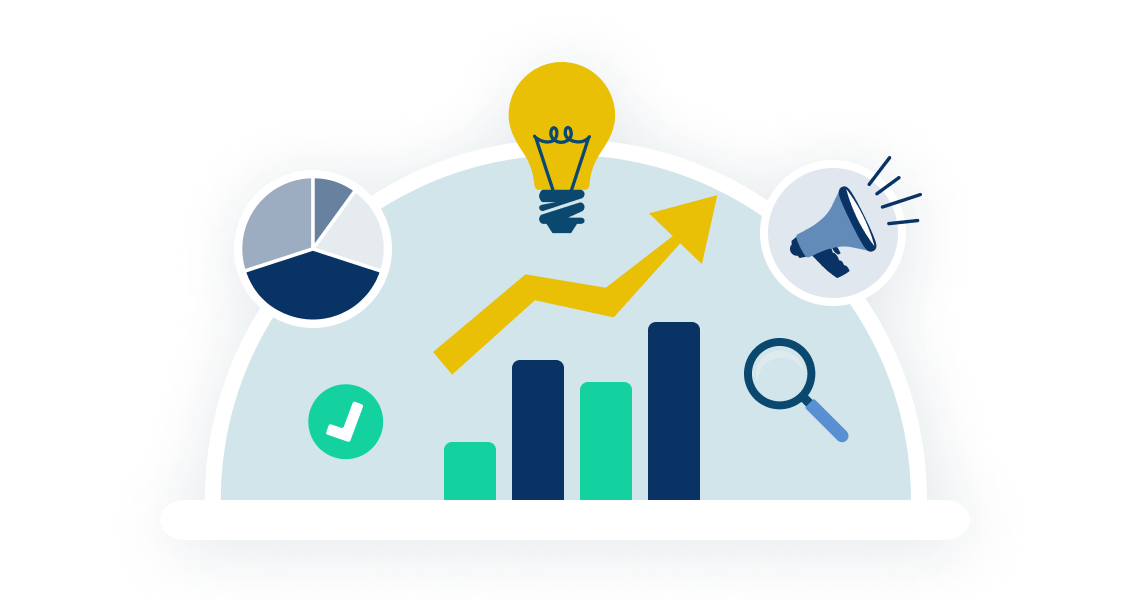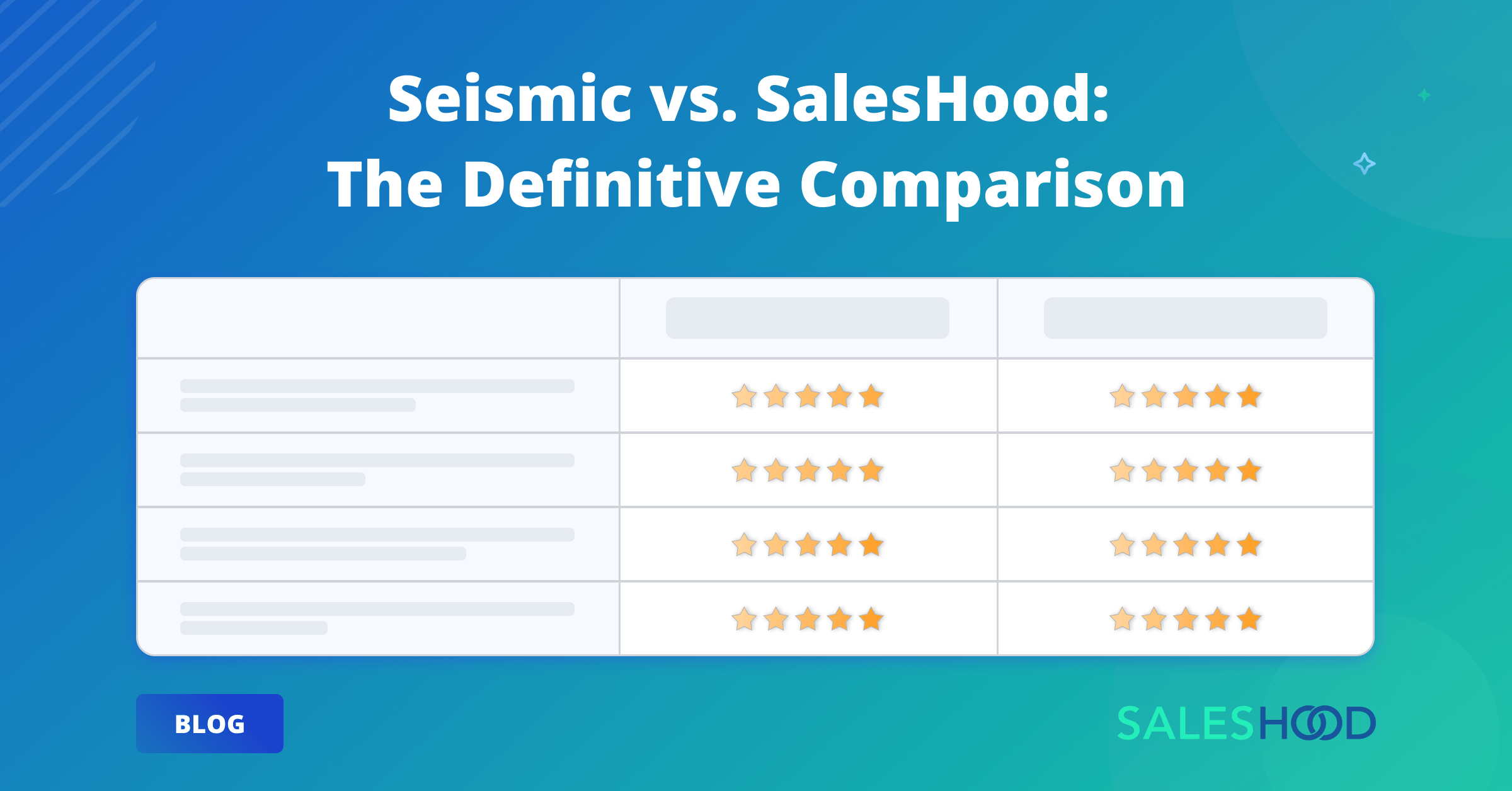Leading indicators look forward, through the windshield, at the road ahead. Lagging indicators look backwards, through the rear window, at the road you’ve already traveled. A financial indicator like revenue, for example, is a lagging indicator. It tells you what has already happened. Leading indicators give us real-time coaching opportunities — for example, looking at rep activities or call connects. Lagging indicators, such as revenue or quota attainment, tell us what’s already happened. These measures give us the ability to review and strategize.
When measured in tandem, leading and lagging indicators provide us with the most holistic view of sales performance. Leading indicators allow us to look forward at the road ahead, and course-correct. Lagging indicators on the other hand, represent reflection on the road already traveled.
This blog will help sales enablement and revenue leaders identify, measure, and improve the most impactful metrics, KPIs, and activities that positively impact revenue outcomes.
Sales Enablement Impact
The practice of sales enablement has matured. Companies are spending billions hiring and developing sales teams. Money is being poured into enablement programs and sales tools to boost productivity. Why are we still struggling to boost and measure sales productivity? We believe we’re not measuring the right behaviours and subsequently not enabling our teams the right way either. Once we know what data look at and when to look at it, we’ll be able to drive up the benefits of our sales enablement investments.
One of the most common questions we hear is:
“What sales activities and metrics have the biggest impact on revenue outcomes and why?”
By identifying the most impactful sales productivity metrics, we can better understand their impact on sales pipeline, sales pipeline progress, sales effectiveness and revenue outcomes. The holy grail of sales enablement is to easily and systematically correlate our sales enablement programs to:
- Better sales
- Improved win-rates
- Shorter and more efficient average sales cycle length
- Deal progression
- Higher contact and conversion rates
- Time to ramp
- Quota attainment
Challenges with measuring sales productivity metrics & KPIs
Over time it’s become clear that as enablement professionals, we’re great at coaching, building content, facilitating sales training, rolling out programs, etc.
But when it comes to measuring and proving impact, and identifying sales metrics that are directly improving sales productivity, some enablement practitioners struggle. We need to better understand and measure the metrics and KPIs that ultimately will help sales reps move revenue needles.
Training completion, assessments, quizzes, certifications and pitch practice are all great to measure. But these are consumption metrics and they need to be correlated with performance data. These metrics don’t directly measure impact, value, and measurable results.
The reason why enablement professions struggle with analytics, metrics and KPIs is:
- Lack of understanding of the end-to-end flow of data for sales process and buyer’s journey
- Limited access to data and systems to assess the data
- Difficult to secure stakeholder engagement
- Stakeholder alignment is hard to execute around what metrics matter the most
- Benchmarking performance is complex
How do you calculate sales productivity?
As sales enablement evolves and matures, it will become increasingly more important to prioritize benchmarking and measuring metrics and KPIs. We’ll need to answer the questions:
- How are we currently measuring sales metrics?
- Do they directly measure and determine the impact and value?
After asking these questions, you can then evaluate these metrics to determine exactly how and what you are measuring.
To provide a greater impact on the company you will need to understand the activity, conversion rate, and outcome metrics.
As a sales manager, getting to know these sales productivity KPIs will also allow you to quickly increase sales performance to meet revenue goals. The three main components include:
Activity Metrics
- # emails
- # calls
- # meetings
- # opportunities
Conversion Metrics
- Deal progression
- Stage progression
- Win rates
- Renewal rates
Outcome Metrics
- Booking
- Average lead response time
- Average sales cycle time
- Average deal size
- Customer acquisition cost
- Customer lifetime value
Getting a better idea of these key performance indicators will help sales leaders determine sales productivity and establish ways for these sales metrics to lead to achieving the company’s objectives.
Understanding leading indicators
Leading indicators are measurable or observable variables of interest that predict performance before it’s too late. Leading economic indicators are used to forecast changes before the rest of the economy begins to move in a particular direction and help market observers and policymakers predict significant changes in the economy. In sales, leading indicators are early activities we measure to gauge the performance of our team.
We don’t want to wait months until we find out there’s a performance issue we need to rectify. We want to know in days and weeks how our teams are doing. Leading indicators are important sales metrics in the sales process to ensure our salespeople are on track to hit their revenue goals. Leading indicators are important in a new hire onboarding program to see if our new hires are on track to hit their ramp goals.
Leading indicators that provide productivity insight
- # calls made
- # emails sent
- # videos shared
- Open and response rates
- # meetings scheduled
- # opportunities created
- Value of opportunities created
- Sales process stage conversation
Why you should use leading indicators to coach?
Leading indicators help front-line managers and enablement boost productivity, ensure revenue goals, and allow for continuous growth within the sales cycle, as well as future growth.
- Greater teamwork within sales teams – Tracking sales team productivity metrics encourages increased interaction within your sales force, improving not only sales performance metrics but also teamwork, sales effectiveness, and sales efficiency.
- Ability to adapt sales strategy – Since leading indicators provide early sales activity metrics, it allows sales management to adapt the strategy to improve projected results.
- Constant and quicker feedback – Early sales activity metrics provide quick and constant feedback to the sales rep and ensure the sales process is going smoothly.
- Used for benchmarking – By taking data early on and after the task, sales data analysis can be done to determine the sales efficiency of the entire sales cycle, allowing managers to make the necessary changes and improvements for the next sale.
- Allow for continuous improvement – Since leading metrics are taken throughout the process early on, it’s a quick and effective method to make sure the sales team is on track to meet goals.
Why lagging indicators are too late?
Lagging indicators look backwards, through the rear window, at the road you’ve already travelled. A lagging indicator is a metric that can measure sales effectiveness. It helps us determine the business impact that has already been made.
Many companies today focus primarily on lagging indicators like:
- Revenue Bookings
- Quota Attainment
- Win-Rates
- Renewals
- Customer Churn Rates
These are important, but there’s not much we can do after they happen.
Cons of lagging indicators
- Takes much longer to measure – Since lagging indicators are measured throughout the entire process, the data is not able to be interpreted and analyzed until much later. If you’re looking to actively improve sales rep productivity during the sales process, lagging data takes too long.
- Many factors may impact the data – While lagging metrics directly show the overall outcome, there are several different factors that influence it. With lagging indicators, these important factors are not shown, making it difficult to determine the actual cause or action that positively or negatively influenced the outcome.
- Hard to make changes – The outcome is usually a result of the entire sales team. Since the impact is hard to determine, it’s difficult to make changes to positively affect the outcome. This impacts sales training and puts focus on the wrong areas.
- Unable to quickly adapt during the selling process – Sales processes may require proactive adaptation and fluidity, but lagging metrics would not be of any help in this situation.
Build enablement plans with leading indicators by role
Different positions in a sales organization will require you to take different metrics into account. Here are examples by role to follow as a guide. Once these plans are complete, they will inform training, onboarding, compensation and forecasts. In short, plans by role with metrics and KPIs that are measured in real-time will drive better productivity. Getting this right is a real business multiplier.
Sales Development
Typically with sales development, you’ll be looking to integrate training completions and certifications from a system like Saleshood with activity data from systems like Salesforce, Salesloft and Outreach. In some cases, correlation will include intgerations with incentive compensation systems like Xactly but this would be a lagging indicator. Here’s a list of sales development leading indicators.
- Training completion
- Certification pitch & call certifications
- # calls made
- # videos shared
- # emails sent
- # meetings scheduled
Account Executives
Regardless of segment (small business, mid market or enterprise), the plans by role for these sellers all have very similar leading and lagging indicators to measure. Here’s a list of account executive leading indicators.
- Training completion
- Certification pitch & call certifications
- # calls made
- # videos shared
- # emails sent
- # meetings scheduled
- Time to first meeting
- Time to first demonstration
- TIme to first deal
- Time to second deal
Customer Success
Those that try to do a one size fits all to enablement fail. When we look at leading indicators and the supporting training and coaching requires to help make customer success professionals productive and successful, it’s very different than sales development and account executives. The activities are different. Some skills may be the same. The processes are different forcing us to look at their leading indicators differently.
- Training completion
- Certification pitch & call certifications
- # emails sent to customers
- # customer meetings scheduled
- Time to first meeting
- Time to first quarterly business review
Enable front-line managers to coach with data
As a sales manager, diagnosing where the issues are taking place ensures the success and productivity of your team. Some steps take include:
- Focusing on increasing average lead response time – Having a high lead response time helps to ensure that the customer feels important and decreases the time between selling stages.
- Lead generation sales metrics – Sales reps often waste time generating leads and reaching out to prospects that aren’t qualified or interested. A targeted cold call approach based on leads that meet ideal criteria will lead to more successful calls.
- Conducting meeting recaps – Sales managers should be proactive in gathering feedback from sales reps. Meeting recaps will help you as a sales manager better problems.
- Requiring call recordings – Call recordings are the most valuable data you can have to assist your team analyze and find true solutions for closing deals.
Work with operations to map systems to processes
Bringing enablement and operations together to discuss processes, systems, data and sales metrics is a win-win. The recommendation is to start small. Pick a role and map out the enablement plan for that role. Follow these steps:
- Pick a role
- List out the leading and lagging indicator activities
- Get front-line managers and sales leaders to verify the list
- Map out the data sources and systems for each activity
- Identify the BI (business intelligence) system of record to correlate the data
- Create a timeline and project plan to get all the systems integrated
- Model the reports and dashboards
- Build and share the final reports and dashboard with all stakeholders
Getting this project right will result in huge cross-team process and sales productivity improvements.
Key takeaways
There are many factors that will contribute to successfully tracking the right metrics and KPIs and correlating enablement activity with performance data.
- Understand the differences between leading and lagging indicators
- Build enablement plans by role
- Align your teams on the metrics that matter the most
- Enable front-line managers to coach with data
- Work with operations to build the systems and processes to scale correlation analytics
Working together to help identify, measure, and improve the most impactful sales productivity KPIs will ensure your sales organization exceeds revenue goals.
Measuring sales productivity as sales leader proves challenging as sales productivity KPIs can be difficult to identify, calculate and interpret. SalesHood can help you more easily measure sales productivity metrics. Our sales enablement platform visualizes sales productivity impact by correlating activity to outcomes, helping you to improve key sales metrics, KPI’s and most importantly, revenue. Sign up for your free SalesHood demo today.



